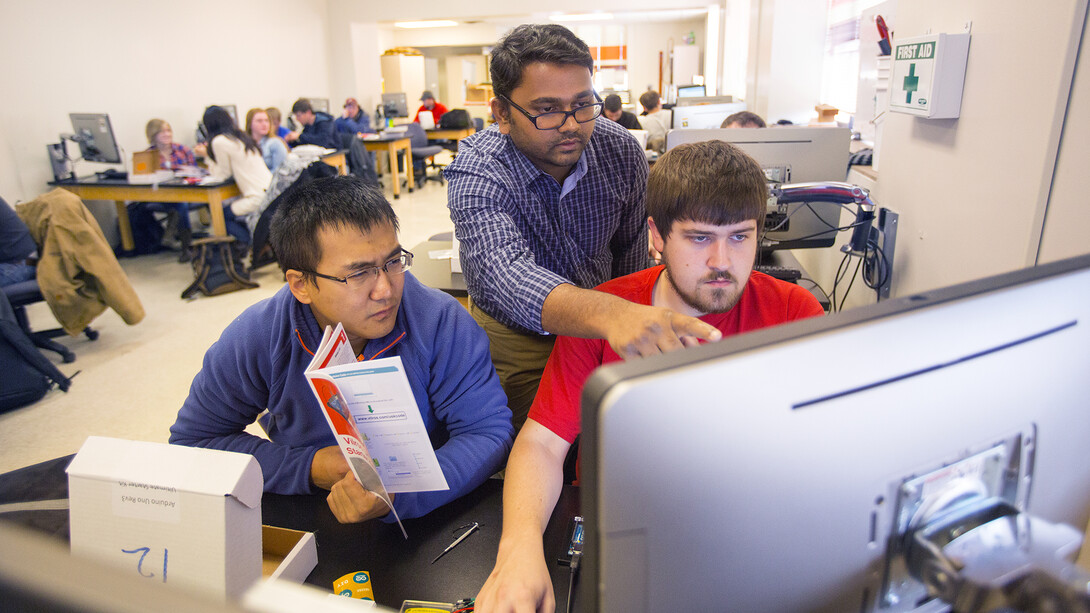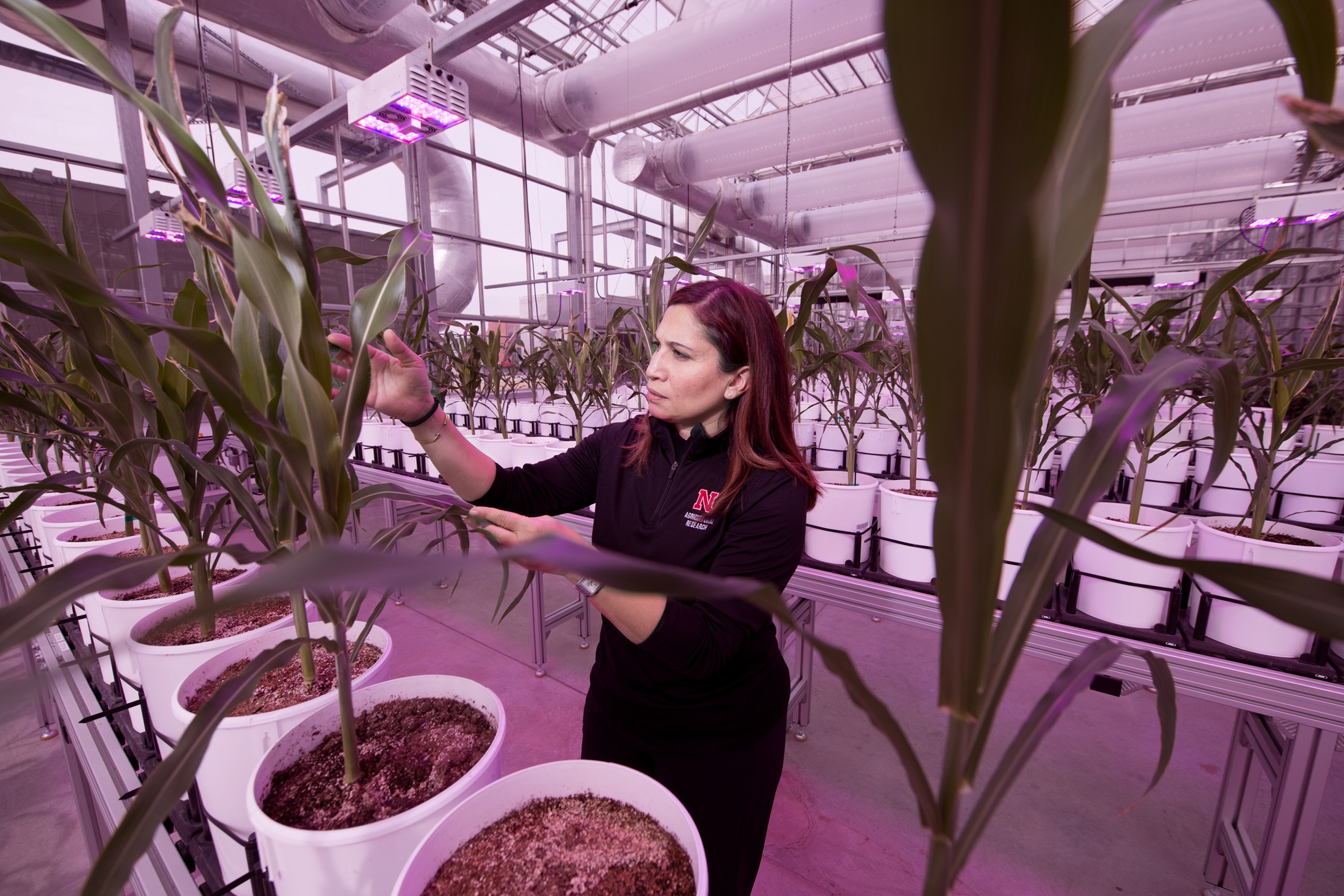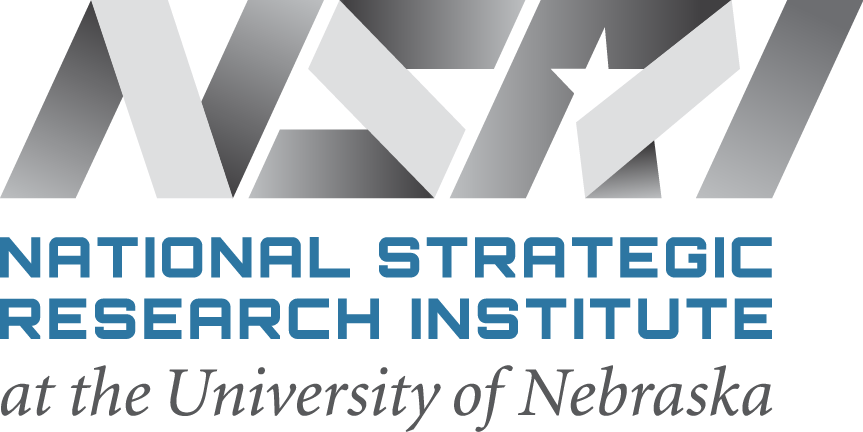Modern agroecosystems are inundated by complex challenges ranging from environmental stresses to human management, cybersecurity and market disruptions. Producers across the globe are seeking innovations that will extend the ability to grow food within and beyond traditional open-field cropping and livestock production environments.
Over decades, Nebraska has leveraged expertise in one very specific aspect of production that is becoming critical to increasing the security, resiliency, stability and sustainability of growing and processing systems: built agriculture.
Built agriculture consists of any manmade structure or equipment that helps producers increase efficiency, automation and safety of food growing systems. It helps address growing pressure to maintain productivity, sustainability and biosecurity in the face of labor shortages, diseases, seasonal variability, limited resources and other potential threats.
"One of the best ways to make our food supply resilient and sustainable is to use technology, new building and production techniques, digital systems and intelligent design to evolve our production capabilities. If you’re looking for innovation in these areas, Nebraska is what you’ve been looking for," said Meghan Jackson, who directs the food, agriculture and environment security (FAES) focus area, a strategic partnership between the National Strategic Research Institute (NSRI) and University of Nebraska–Lincoln’s (UNL) Institute of Agricultural and Natural Resources (IANR).
As one of only 15 University Affiliated Research Centers (UARCs) in the country designated by the U.S. Department of Defense (DOD), NSRI provides perspective and clarity regarding the evolving national security concerns of federal government stakeholders. NSRI partners with the UNL’s IANR to leverage 150 years of experience in agricultural research and a deep commitment to producers and consumers for research and development that matters to the DOD and beyond.

NSRI and IANR, with collaborators, consolidate resources and capabilities to address built agriculture challenges, improving resiliency, protecting cyber systems and nurturing a new generation of workers who understand both physical and digital innovations needed for measurable agricultural advancement.
"Built agriculture systems enable local production and build resilience by compressing the supply chain and minimizing disruptions," explained Dr. Tala Awada, associate dean and associate director of the UNL Agricultural Research Division and a faculty contributor to NSRI.
Fostering Resilience Through Dynamic Research
"Across the globe, we are moving from agrarian societies into a new age of agriculture with new opportunities for enhancing resilience," Jackson said. "We need to be aware not only of historical and current nuclear, biological and chemical risks, but also potential threats that come with the evolution of technology and innovations used in agriculture, food processing and the environment. This is the next frontier."
Both crops and livestock are moving toward greater resilience through the new technologies and processes of built agriculture.
"Livestock production systems face increasing pressure to maintain productivity, sustainability and biosecurity while responding to challenges such as disease threats, labor shortages, climate variability, and resource limitations," explained Dr. Tami Brown-Brandl, UNL professor of biological systems engineering.

Dr. Brown-Brandle, whose research focuses on engineering for improved animal well-being and production efficiency, said built agriculture for livestock includes new and emerging technologies, including AI systems and data tools for advanced monitoring of animal and environment health. The goal is to breed more adaptable animals and build operations for high levels of resilience.
Cropping benefits of built agriculture, according to Dr. Awada, a physiological plant ecologist, include high-density production, both horizontally and vertically. Closed-loop systems of consolidated, automated greenhouses can enhance water and nutrient efficiency, improve predictability of production and provide new, effective methods of detecting and managing system failures.
NSRI and IANR can quickly leverage numerous programs and initiatives to enhance national security, including:
- NFarms, a free decision-support tool built on real farm research
- Nebraska On-Farm Research Network (NOFRN)
- University of Nebraska Testing Ag Performance Solutions (UNL-TAPS) program
- Greenhouse Innovation Center, featuring advanced imaging capabilities
- National Center for Resilient and Regenerative Precision Agriculture (under construction at the time of this writing), a collaborative effort between UNL and USDA
- Space, Policy, Agriculture, Climate, and Extreme Environments (SPACE2) space-ag research
Dr. Santosh Pitla, associate head of research and innovation for UNL Biological Systems Engineering and a SPACE2 faculty member, works in digital agricultural systems on Earth and in space.
"We envision modular, automated greenhouse systems capable of producing food reliably in any environment, from lunar bases to urban neighborhoods," he said. "These systems will integrate AI, secure data infrastructure, redundancy and low-input farming technologies, creating a resilient backbone for global food systems."

Space innovations such as closed-loop food systems and hydroponic fodder production may also help improve the resilience and sustainability of cropping and livestock in stressed environments on Earth.
Much of built agriculture involves consolidation — both within production spaces and across farms — which allows producers to bulk-purchase and reduce the number of workers. In outer space, where growing space is critically limited, consolidation is key.
Cybersecurity: At the Heart of Agricultural Resilience
Built agriculture can be strengthened and made more resilient through cyber systems and AI. Nebraska research has long incorporated early iterations of technological advancements in this area to support crops and livestock. Technologies being built into industrial control systems (ICS) improve efficiency, add capabilities and bolster redundancy.
"Industrial control systems enable continuous monitoring, precise control and automation of environmental and operational processes," said Dr. Chidi Agbo, researcher and assistant professor of cyber systems at the University of Nebraska at Kearney (UNK). "The systems enhance resilience by maintaining safe operations even under disruptive conditions, no matter the cause."
[photo request to Dr. Agbo, UNK]
In crop production, ICS enable precision agriculture through automated irrigation, temperature control and environmental monitoring and detecting threats early. Dr. Agbo said future ICS in crop production will leverage artificial intelligence, cloud-edge computing and sensor fusion.
For livestock, a well-secured and fault-tolerant ICS ensures animal welfare, production continuity and data integrity.
AI systems are largely in the experimental phase for livestock, Dr. Brown-Brandl said.
"Through growing understanding of AI and development of AI models to recognize patterns in animal behavior, it will become easier to detect early signs of disease or stress and optimize management strategies that improve both animal welfare and environmental sustainability," she explained. "These interconnected systems allow timely, data-driven decisions."
Dr. Agbo said future ICS for livestock will include smart, interconnected self-recovery systems that integrate cybersecurity during system design. Emerging technologies such as AI-driven anomaly detection and digital twins will allow systems to predict and respond to faults or attacks in real time.
The importance of cybersecurity naturally extends to space, where closed-loop, resource-efficient ecosystems are dependent on digital control.
On the other end of the food supply chain, many built food processing features keep food safe and fresh as it’s prepared for human use. Dr. Silvana Martini, department head of Food Science & Technology at UNL, explains that "control systems are important to monitor the safety of foods and their changes during storage."
[photo request to Dr. Martini, UNL]
Dr. Martini explained, "More and more automation is being incorporated in food production companies to increase efficiency. Some of the efforts to reduce waste are to upcycle waste ingredients from food processing into healthy food products."
The University of Nebraska System leads several initiatives to strengthen the agricultural cyber ecosystem, including:
- Security Testbed for Agricultural Vehicles and Environments (STAVE)
- National Agricultural Producers Data Cooperative (NAPDC)
- Analysis of Security Vulnerabilities in Agricultural Mobile Applications
- Agricultural Security Operations Center (AgSOC)
- An ICS lab in development on UNK’s campus that will offer hands-on access to real-world operational systems and simulation environments
"As agriculture continues to digitize, ensuring these control systems remain resilient and cybersecure will be essential," Dr. Agbo said.
In fact, said Dr. Pitla, "A secure CEA network is as essential as efficient energy or water use — a core pillar of resilience on Earth and in space."
Dr. Brown-Brandl suggested, "As systems become increasingly connected through sensors, cameras, RFID technologies and cloud-based data storage, ensuring the security, reliability and integrity of systems is becoming just as important as biological and engineering performance."
Cultivating Tomorrow’s Needs Today
With agricultural labor shortages, increasingly complex and interconnected challenges and new workforce demands arising out of emerging technologies, it is more important than ever to focus on creating a workforce educated in resilience and security.
"Future scientists, technologists and innovators need a strong theoretical foundation in their domains but also a good understanding of epistemology," Awada said. "Equally important are systems thinking, practical and experiential learning, and critical thinking skills."

Dr. Agbo added: "They must be skilled not only in IT security but Operational Technology (OT) security, a critical gap in most university programs."
Dr. Agbo’s instruction at UNK is tightly integrated with research on control systems security and resilience, giving students hands-on opportunities to apply risk assessments and practical defenses.
Dr. Brown-Brandl said, "Developing a layered workforce requires collaboration among universities, community colleges, industry and producers, as well as new training programs integrating science, engineering and computer science, with access to real production environments for practical experience."
For livestock, she suggested that future professionals must understand not only how to use technology but also how to apply it responsibly and effectively within complex systems.
At the Food Innovation Center, Dr. Martini and colleagues provide learning opportunities through the Food Science and Technology program, including hands-on work in research labs, a pilot plant and services areas of the Food Processing Center. Teaching and research programs include topics related to the bioeconomy and circular economy. An undergraduate summer program covers the entire pipeline from raw agricultural input to consumer product prototypes.
To support Nebraska’s investment in space ag education, Dr. Pitla and others provide mentoring in NASA’s Plant the Moon Challenges and teach innovative classes such as AGEN 100 (biodome projects). The department is developing interdisciplinary Capstone projects on "Greenhouses in Space," bringing together engineering, agriculture, science and law students to solve complex, system-level problems.
The University of Nebraska’s long history of agriculture education, educational facilities, diversity of programs and a rich body of research going back generations support the preparation of a capable workforce to meet the complex emerging challenges of agriculture.
Ready to Respond
Nebraska has a strong foundation in agricultural engineering, water systems and biosecurity research, plus cutting-edge cybersecurity and cyber systems research, and strong support for space ag solutions.
"We are committed to enabling the expertise, infrastructure, transdisciplinary research and collaborations, stakeholder engagement from local to global scales, and education needed to meet the needs of agriculture as it changes," Awada said.
With NSRI and IANR supporting and promoting built agriculture research and science-based innovations that meet security, safety, resilience and sustainability goals, the University of Nebraska stands prepared to apply real-world farming solutions to help the nation and world protect its food, agriculture and environment.
"Humans are always going to need to eat," Jackson said. "A government or nation will always have to feed its people, provide them with water to drink and ensure they have air to breathe. Making those foundations of life safe and secure will always be important, and we need to be prepared to meet whatever challenges arise."
Learn more about NSRI's food, agriculture and environment security focus area at nsri.nebraska.edu/faes.
